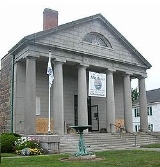
Pilgrim Hall Museum
Encyclopedia
The Pilgrim Hall Museum in Plymouth, Massachusetts is the oldest public museum
in the United States
in continuous operation, having opened in 1824.
and Plymouth Colony
. Architect Alexander Parris
designed the museum building, which opened in 1824. Russell Warren
constructed a wooden portico
in 1834. The top part of Plymouth Rock
sat in front of the building from the 1830s to 1880s until it was reunited with the bottom half in the Plymouth waterfront. The museum was extensively upgraded in the 1880s. In 2008, an addition was added to the museum along with a new sign, activities, and advertising throughout the downtown area.
and a 1651 portrait of Edward Winslow
, the only known Pilgrim portrait. The museum owns the 1626 shipwreck
of the Sparrow Hawk, the only known remains of a trans-Atlantic 17th century ship, but the ship is currently (2009) displayed at the Cape Cod Maritime Museum.
Museum
A museum is an institution that cares for a collection of artifacts and other objects of scientific, artistic, cultural, or historical importance and makes them available for public viewing through exhibits that may be permanent or temporary. Most large museums are located in major cities...
in the United States
United States
The United States of America is a federal constitutional republic comprising fifty states and a federal district...
in continuous operation, having opened in 1824.
History
The Pilgrim Society, established in 1820, runs the museum. The museum tells the story of the PilgrimsPilgrims
Pilgrims , or Pilgrim Fathers , is a name commonly applied to early settlers of the Plymouth Colony in present-day Plymouth, Massachusetts, United States...
and Plymouth Colony
Plymouth Colony
Plymouth Colony was an English colonial venture in North America from 1620 to 1691. The first settlement of the Plymouth Colony was at New Plymouth, a location previously surveyed and named by Captain John Smith. The settlement, which served as the capital of the colony, is today the modern town...
. Architect Alexander Parris
Alexander Parris
Alexander Parris was a prominent American architect-engineer. Beginning as a housewright, he evolved into an architect whose work transitioned from Federal style architecture to the later Greek Revival. Parris taught Ammi B. Young, and was among the group of architects influential in founding what...
designed the museum building, which opened in 1824. Russell Warren
Russell Warren (architect)
Russell Warren was an American architect, best known for his Greek Revival style, and notably the design of the Weybosset Arcade, now known as the Westminster Arcade in Providence, Rhode Island.Warren was born in Tiverton, Rhode Island...
constructed a wooden portico
Portico
A portico is a porch leading to the entrance of a building, or extended as a colonnade, with a roof structure over a walkway, supported by columns or enclosed by walls...
in 1834. The top part of Plymouth Rock
Plymouth Rock
Plymouth Rock is the traditional site of disembarkation of William Bradford and the Mayflower Pilgrims who founded Plymouth Colony in 1620. It is an important symbol in American history...
sat in front of the building from the 1830s to 1880s until it was reunited with the bottom half in the Plymouth waterfront. The museum was extensively upgraded in the 1880s. In 2008, an addition was added to the museum along with a new sign, activities, and advertising throughout the downtown area.
Collections
The Pilgrim Hall Museum contains artifact collections, artwork, a library and archives. Prominent pieces include original Pilgrim era artifacts, such as the original Brewster ChairBrewster Chair
]A Brewster Chair is a rare style of chair made in mid-17th century New England.-Origin:The "Brewster Chair" was named after Willam Brewster, one of the Pilgrim fathers who landed in Plymouth, Massachusetts in 1620. In 1830 the Brewster family of Duxbury donated Elder Brewster's original chair to...
and a 1651 portrait of Edward Winslow
Edward Winslow
Edward Winslow was an English Pilgrim leader on the Mayflower. He served as the governor of Plymouth Colony in 1633, 1636, and finally in 1644...
, the only known Pilgrim portrait. The museum owns the 1626 shipwreck
Shipwreck
A shipwreck is what remains of a ship that has wrecked, either sunk or beached. Whatever the cause, a sunken ship or a wrecked ship is a physical example of the event: this explains why the two concepts are often overlapping in English....
of the Sparrow Hawk, the only known remains of a trans-Atlantic 17th century ship, but the ship is currently (2009) displayed at the Cape Cod Maritime Museum.

